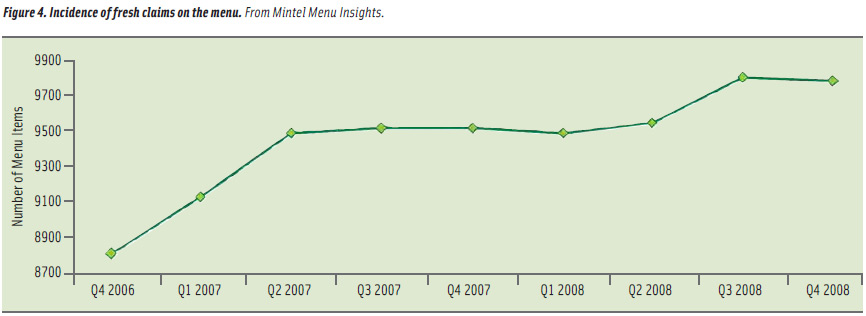Putting Health on the Menu
Mintel research reveals how consumers really feel about better-for-you foodservice fare.
Healthy eating and dining out are two phrases that sometimes don't seem to go together. Research and observation have shown that many people dine out to indulge themselves. However, consumer interests are changing, and healthy and dining out can fit together. According to market research company Mintel (www.mintel.com), 77% of consumers would like to see more healthful options added to the menu. And 63% say that eating healthy is difficult because there are not enough healthy items on the menu.
 It used to be that healthy menu items were the "kiss of death" for restaurants. These menu items were filled with the "lows and nos" of eating, which often translated to low and no satisfaction. But restaurant operators should not be fooled by old ways of thinking about health on the menu. The key to successful healthy menu items involves understanding not only what consumers believe is important to good health, but how their personal beliefs can be woven into the decision to order what they want.
It used to be that healthy menu items were the "kiss of death" for restaurants. These menu items were filled with the "lows and nos" of eating, which often translated to low and no satisfaction. But restaurant operators should not be fooled by old ways of thinking about health on the menu. The key to successful healthy menu items involves understanding not only what consumers believe is important to good health, but how their personal beliefs can be woven into the decision to order what they want.
Less Nutrition Disconnection
We hear of the importance of healthy eating daily through various media outlets. Diet positively impacts our health and quality of life. Despite the benefits of a healthy diet, the United States has a health crisis on its hands. The obesity rate among adults has more than doubled from 1976 to 2004. But there is some good news. The overweight and obesity rates have leveled off , which suggests that more people are watching their diets.
According to Mintel's May 2009 Healthy Dining Trends report, approximately two-thirds of consumers say their diets are healthy - or at least somewhat healthy (see Figure 1). As far as collective self-image goes, that's not too bad. It suggests that most consumers are making an attempt at incorporating healthy eating habits into their lifestyles. Consumers are also aware of the importance of eating healthy foods, as some 86% say that eating healthy is at least "somewhat important" (see Figure 2).
While the statistics cited here reveal something of a disconnect between what consumers believe and what they do, it's clear that many are interested in eating a more-healthful diet. And that means opportunities for restaurants to deliver more better-for-you menu options.
Restaurant patrons typically have two goals when they are eating out: good taste followed by hunger satisfaction. The health rules people set for themselves become harder to follow when they are in the restaurant and faced with the decision of ordering what they would enjoy most or what would be best for them. It means that healthy items need to taste great and satisfy hunger in order to connect with the patron's need. Of course, it should also be noted that, according to Mintel's Healthy Dining Trends report, 20% of those who eat dinner out "want to closely watch" what they are eating.
How Consumers Define Healthy
Creating healthy menu items that consumers will want to repeatedly eat means listening to their opinions on what "health" actually means to them. Freshness, fat, and vegetable content are attributes of a healthy meal that bubble to the surface for consumers (see Figure 3). This allows restaurant operators to connect with a broad audience.

--- PAGE BREAK ---
According to Mintel, the freshness of a menu item is the No. 1 reason for choosing a healthy meal at a restaurant (49% of consumers). When it comes to eating "fresh" diners are in luck as restaurant menus have increasingly incorporated fresh ingredients into their offerings, with a 22% increase in "fresh" claims since 2006 (see Figure 4). Subway encourages patrons to "eat fresh." Panera Bread suggests that restaurant goers "pick something fresh," and Red Lobster invites consumers to "come see what's fresh today." Hitting the fresh factor promises diners a certain level of healthfulness, a sense of high quality, and food that is natural and in an unaltered state.
The appeal of fresh is that it is universally applicable. From appetizers to desserts, fresh ingredients increase the nutrition quotient of the menu item. Fresh fruit desserts and fruit soups are appearing on menus with increasing frequency, and fruit is being incorporated in everything from salads to cocktails.
Recently, the Long John Silver's restaurant chain has begun "Throwing Boring Overboard" with its Freshside Grille enticing consumers to "Discover the Freshside of Great Taste." This new menu extension features grilled seafood and vegetable options and three meals with 10 g of fat or less.
Fat: The Good, the Bad, and the Ugly
When it comes to fat on the menu, low-fat, fat-free, trans-fat-free, etc., are still common terms. And as pointed out in Figure 3, 39% of consumers are interested in menu items with lower fat content. The number of fat claims on the menu that are tied to ingredients is going up. This way, low-fat does not have to take center stage. It can instead supplement the menu item, which helps consumers make decisions on taste and flavor, while feeling better about their choice.
This is also why low-fat doesn't have to mean low-flavor anymore. Max and Erma's created one of its No Guilt menu items to scream, "H-E-L-L-O, skinny jeans!" These Black Bean Roll-Ups are made up of five tortillas filled with spicy black beansB and veggies, served with low-fat Tex-Mex dressing and fresh pico de gallo.
Jamba Juice introduced the power of antioxidants into its Reduced-Fat Blueberry Lemon Loaf that boasts, "All of the goodness with none of the guilt." The marketing tagline goes on to state: "The antioxidant power of plump blueberries is baked into an all-natural, lemony loaf to give your day a "berry" good start." People generally equate vegetables with health, and 29% of consumers look for more of them in healthy meals. In this area, restaurants might be dragging their feet. Mintel has seen only a 2% increase in vegetables on menus from Q4 2006 to Q4 2008. However, this provides tremendous opportunity for vegetable content and variety on the menu.
The Power of Suggestion
Behind each of these food factors (freshness, fat content, and inclusion of vegetables) - and behind every dining decision - lie emotions. And while these food factors help give customers the food content they want, it's also up to restaurant operators to add another layer of positive emotion to the decision.
--- PAGE BREAK ---

Positive messaging is very important. The way food or beverage items are described can help make the consumer feel good about what they are eating or drinking. When a menu item delivers on taste, appetite satisfaction, flavor, and appearance - but is also wreathed in positive messaging - who can resist it? Think of it this way:
- Positive messaging takes a look at feelings described by key words in menu item descriptions.
- Positive messaging brings attention to the good things about food and beverages.
- Positive messages can be derived from looking at consumers' interest in food trends.
- Positive messages speak directly to consumers' emotions.
Word choices on menus are critical to positive messaging. To communicate that a food or beverage item contributes to physical wellness, for example, foodservice operators might use terms like "heart smart," "skinny," "guilt-free," or "health-conscious" on menus. Words like "crave," "satisfying," or "filling" may be used in the context of demonstrating that a product delivers satiety benefits. The menu appeal of terms like "refreshing," "cooling," or "invigorating" is readily apparent; consumers have often turned to food and drink to revive or revitalize themselves. Similarly, a menu might promote the relaxation benefits of an item with terms like "cool down" or "restore."
Meeting the Challenge of Menu Transparency
Even with all of the interest in healthy dining, few restaurants provide nutrition information at the point of ordering. As a result, consumers often get more calories, fat, and salt than they realize. Without clear, easy-to-use nutrition information at the point of ordering, it's difficult to make informed choices at restaurants.

--- PAGE BREAK ---
This was the subject of a series of studies by Brian Wansink, Director of Cornell University's Food and Brand Lab. Wansink's research demonstrated that consumers tend to overestimate the healthiness of fast-food sandwiches. Most of the studies compared Subway, which touts itself as a more-healthful option, and McDonald's.
In one study, 46 students were given a coupon either for a McDonald's Big Mac, which has 600 calories, or for a Subway 12-inch Italian sub sandwich with about 900 calories. The students weren't told how many calories were in their sandwiches.
Those who received the Subway coupon were more likely to order a large drink and less likely to want a diet soda. They were also more likely to add chocolate chip cookies. They ended up ordering a meal with an average 1,011 calories, while those with the McDonald's coupons ordered meals with an average of 648 calories.
Transparency: The New Government Mandate
More than 20 states and localities are considering policies that would require chain restaurants to provide calorie totals and other nutrition information on menus and menu boards. New York City was the first to implement a program that required restaurants to post calorie totals, and effective July 1, 2008, the city health department banned trans fats from menu items. Philadelphia has also mandated menu labeling; in November 2008, the City Council ruled that restaurant chains with 15 or more units must list calories, saturated fat, trans fat, carbohydrates, and sodium content, effective January 1, 2010.
In response to continuing concerns about the healthfulness of consumer lifestyles, the U.S. federal government may soon be stepping into the ring. The Labeling Education and Nutrition (LEAN) Act introduced by legislators this spring would serve as a vehicle for assessing what's on the local restaurant menu. The proposed legislation, strongly supported by the National Restaurant Association, would require restaurants and grocery stores with 20 or more locations to include calorie information on their menus. Such menu labeling would allow Americans to exercise personal responsibility and make informed choices for a growing part of their diet.

Maria Caranfa, R.D., ([email protected]) and David Morris, J.D., ([email protected]) are, respectively, Director, Mintel Menu Insights, and Research Director, Mintel International, 351 W. Hubbard St., Floor 8, Chicago, IL 60654.
